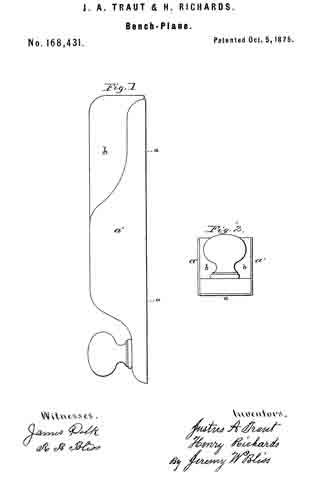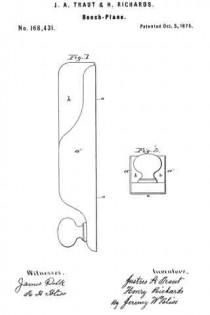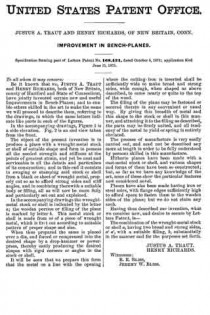No. 168,431 – Improvement In Bench-Planes (Justus A. Traut And Henry Richards) (1875)

UNITED STATES PATENT OFFICE.
_________________
JUSTUS A. TRAUT AND HENRY RICHARDS, OF NEW BRITAIN, CONN.
IMPROVEMENT IN BENCH-PLANES.
_________________
Specification forming part of Letters Patent No. 168,431, dated October 5, 1875; application filed June 15, 1875.
_________________
To all whom it may concern:
Be it known that we, JUSTUS A. TRAUT and HENRY RICHARDS, both of New Britain, county of Hartford and State of Connecticut, have jointly invented certain new and useful Improvements in Bench-Planes; and to enable others skilled in the art to make the same we will proceed to describe them, referring to the drawings, in which the same letters indicate like parts in each of the figures.
In the accompanying drawings, Figure 1 is a side elevation. Fig. 2 is an end view taken from the front.
The object of the present invention is to produce a plane with a wrought-metal stock or shell of suitable shape and form to possess all the needed strength and stiffness at the points of greatest strain, and yet be neat and serviceable in all the details and particulars of its construction; and to this end it consists in swaging or stamping said stock or shell from a blank or sheet of wrought metal, properly cut so as to afford strong sides and stiff angles, and in combining therewith a suitable body or filling, all as will now be more fully and particularly set out and explained.
In the accompanying drawings the wrought-metal stock or shell is indicated by the letter a; the wooden portion or filling of the plane is marked by letter b. This metal stock or shell is made from or of a piece of wrought metal, which is first cut according to suitable pattern of proper shape and size.
When thus prepared the same is placed over a die, and forced or compressed into the desired shape by a drop-hammer or power-press, thereby easily producing the desired shapes with rigid corners or angles in the stock or shell.
It will be seen that we prepare this form that the metal on a line with the opening where the cutting-iron is inserted shall be sufficiently wide to make broad and strong sides, wide enough, when shaped as above described, to come nearly or quite to the top of the wood.
The filling of the plane may be fastened or secured thereto in any convenient or usual way. By giving this breadth of metal and this shape to the stock or shell in this manner, and attaching it to the filling as described, the parts may be firmly united, and all tendency of the metal to yield or spring is entirely obviated.
The process of manufacture is very easily carried out, and need not be described any more at length in order to be fully understood by persons skilled in this manufacture.
Hitherto planes have been made with a cast-metal stock or shell, and various shapes and forms of them have been so constructed; but, so far as we have any knowledge of the art, none of these show the particular features now considered novel.
Planes have also been made having iron or steel soles, with flange edges sufficiently high to afford space to fasten them to the wooden sides of the plane; but we do not claim any such.
Having thus described our invention, what we consider new, and desire to secure by Letters Patent, is —
The combination of the wrought-metal stock or shell a, having two broad and strong sides, a a’, with a suitable filling, b, substantially in the manner and for the purposes set forth.
JUSTUS A. TRAUT.
HENRY RICHARDS.
Witnesses:
R. R. BLISS,
JEREMY W. BLISS.


